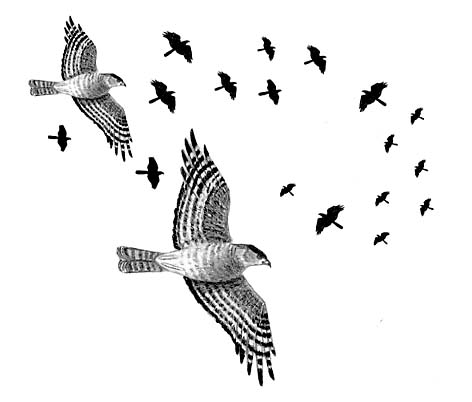
Dear Bird Folks,
Today I saw four Cooper’s Hawks gliding across the sky. A few days prior to that, I discovered a Great Horned Owl that sat in a tree for about five or six hours, then silently flew away. What’s going on? I know Great Horned Owls typically don’t travel far from home. But what about the hawks; are they migrating? Will they stay? And, would the owl ever eat the hawks?
-Jeff, Old Saybrook, CT
You know Jeff,
I enjoy watching birds as much as the next guy. Actually, I enjoy watching them more than the next guy, because I’ve met the next guy and he doesn’t even like birds. But even I would find it hard to stare at an owl for “five or six hours.” After the first three or three and a half hours my mind would start to wander and I would have to go some place to eat brownies or something. I’m impressed that you were able to stay with it for nearly six hours. Either you are very dedicated or there isn’t much else going on there in Old Saybrook. Maybe someday you should take a ride over to New Saybrook. I heard that town rocks.
You were right when suggesting the hawks that you saw were migrating. When we think of migrating birds, we think of the noisy flocks of ducks and geese that fill the fall sky, or the summer songbirds that are here one day and gone the next. Only those who are really paying attention are able to detect the migration of hawks, which, when the conditions are right, can be one of the most dramatic of all.
Hawk migration is a fairly drawn out event. Beginning in mid August and running into late November, hawks leave their woodland nesting grounds and begin to push southward. As oppose to songbirds, which migrate under the cover of darkness, hawk migration is a diurnal event. Why then, if it takes place in broad daylight, does their migration go mostly unnoticed? Because, unlike you Jeff, most people don’t seem to look up. Most of us would rather shuffle along, head down, looking for a lost winning lottery ticket. Also, massive flocks of noisy hawks aren’t drawn to obvious food sources like migrating waterfowl or shorebirds are. But that is not to say there aren’t great hawk watching spots. Weather and geography work together to channel migrating hawks to certain locations. These locations are called “funneling spots” and if you are at one of these funneling spots when the conditions are right, you’ll see more hawks on one day than you would see at a week-long John Wayne film festival.
Some migrating hawks follow mountain ridges. The mountain slopes and heat of the sun combine to create updrafts, a cushion of air that allows the birds to glide for great distances and thus conserve energy. Another major hawk migration route, often taken by Cooper’s Hawks, is along the coast. Hugging the coastline is a clever way that hawks have chosen to keep themselves from getting lost, but there is a problem. It seems that many of the big bad hawks are afraid to fly over water. Can you believe it? What wimps. Hummingbirds do it without a second thought, but the sight of large bodies of water gives hawks cold talons.
Each fall, northwest winds push thousands of migrating hawks along the Jersey shore to Cape May. When they get to the tip of Cape May the birds must decide whether to make the scary 17 mile flight across Delaware Bay or spend the night in New Jersey, which can be just as scary. While deciding what to do the hawks soar around in large circles called “kettles.” These kettles sometimes contain thousands of hawks, creating a thrilling show for bird watchers and causing shear terror in the hearts of rabbits, mice and all of the small mammals of the New Jersey countryside.
Cooper’s Hawks can be found in Connecticut anytime of the year, but they are mostly seen alone, except during nesting season, or migration. That is why I’m pretty sure the four Cooper’s Hawks that you saw, soaring over Old Saybrook, were migrating. Good for you and your sharp eyes, Jeff. Small groups of migrating hawks usually go unnoticed. It isn’t until many of them are funneled into one area that the rest of us take notice.
As for your long stared-at Great-horned Owl eating these hawks, the moving hawks have little to fear. Oh sure, the owl would eat them if it got the chance, but the owl hunts at night. The speedy hawks are safe during the day, but that all changes after dark. That’s the main reason why hawks that go to those famous late night parties in New Saybrook always go home in a cab.